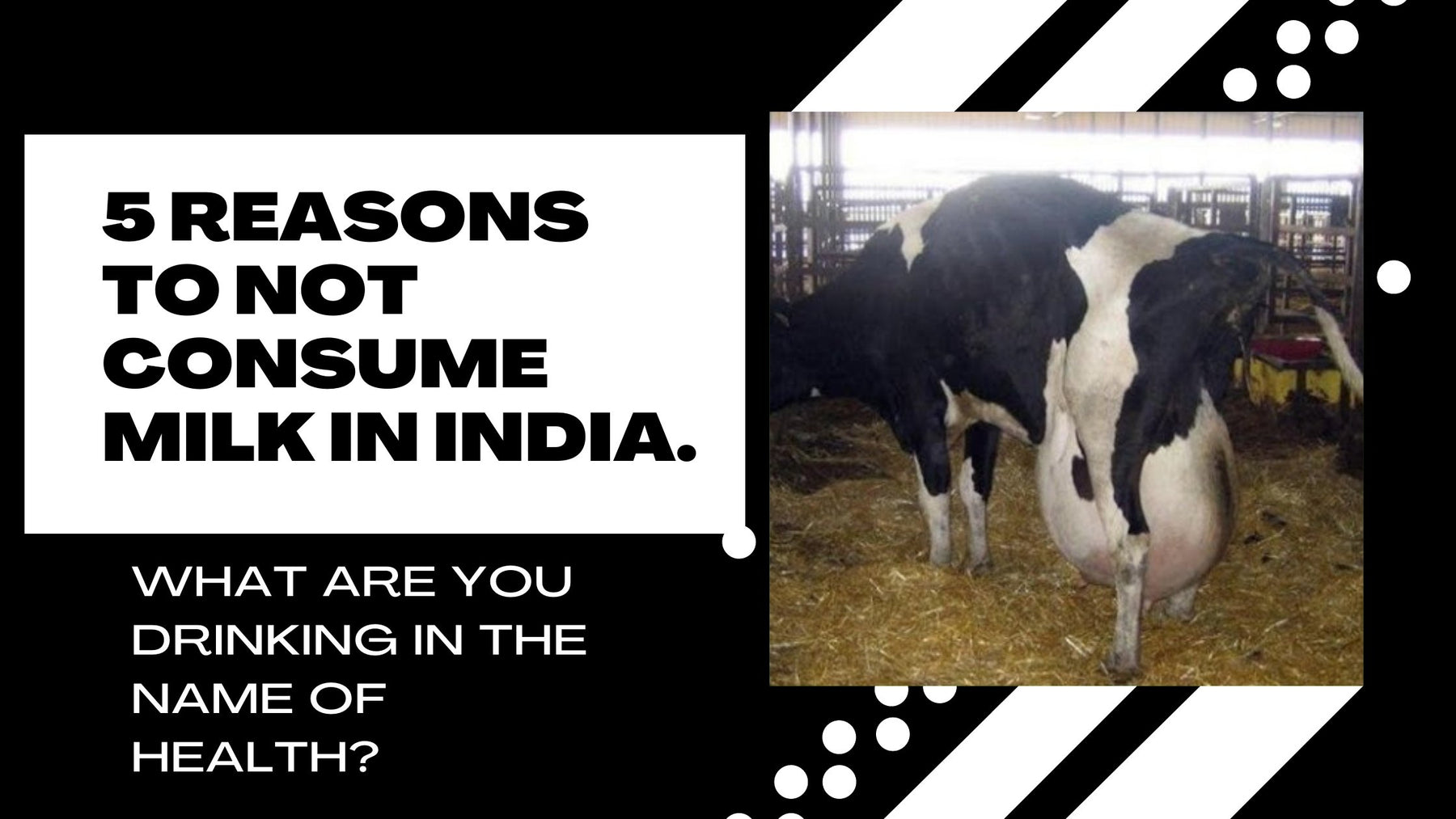
5 Reasons To Not Consume Milk In India
Table Of Content
India is the biggest exporter and producer of milk. With the Indians' respect for the cows, you would think that the quality of milk we get must be top notch. However, the reality is distressing.
Before I get into why consuming milk is a bad idea in India, let's understand some facts.
Despite the promise of quality milk from leading dairy brands like Amul or Mother Dairy, it is heavily contaminated. This is true even after putting stern food regulations and safety rules by the government.
In 2016 the FSSAI (Food Safety and Standards Authority of India) release a statement strongly warning against the contaminants found in milk samples tested in India. The survey is the most systemic and one of the largest ones done so far. Moreover, the Ex Union Minister for Science and Technology Harsh Vardhan states that over 68 percent of the milk sold does not meet food safety and standards.
The study displayed that due to poor farming techniques and the lack of sanitation/ hygiene in the milk packaging and handling, milk is contaminated. Out of the 6432 samples tested for safety and quality 41 percent were adulterated with pesticides, aflatoxin M1, maltodextrin, sugar, urea, glucose, and formalin. These adulterants are often added to enhance the milk’s viscosity and thickness so that the shelf life increases.
Some sample failed because antibiotic residues were found above the level of tolerance. Often times, due to repeated pregnancies and lack of medical attention, cow's develop mastitis (refer to the picture below). They are treated with strong drugs such as oxytetracycline, which make its way into the milk you pour into your cup of chai every morning.

The bad news does not stop at just that because many tested samples contained detergents. These detergents used for cleaning purposes are not properly washed off hence make way into the packaged milk. Besides this, detergents were also used as thickening agents and added to milk.
Another news headline in 2018 that shocked the nation was when 4852 kilograms of adulterated khoya was seized in Pune. Upon on-the-spot inspection by the FDA officials it was found that, the khoya was adulterated with arrowroot powder, caustic soda, starch, urea-mixed milk, and artificial chemicals of sweetening. This is not a one of a kind headline, but is often the story during festival seasons such as Diwali in India. How do you think India keeps up with the Rs. 50,000/- crore (and growing) worth sweets and biscuit market every year.
Right after the khoya and milk, milk powder also tops the charts when it comes to adulteration. Adulterants added to milk powder include melamine, sugars, hydrogen peroxide, salicyclic acid, formalin, urea, and benzoic acid. Mind you, all these adulterants can cause intestinal inflammation, gastritis, diarrhoea, and overburden the kidneys. These are just the effects of contaminants to milk though, even without any contaminants, milk is not the right choice for you and here is why:
For this article though, let's stick to the contaminants found in milk. Read on to know more about why you cannot consume milk in India. Let's understand the five key points to avoid milk consumption in India though.
1) Detergents: Dioxane (known carcinogenic)
You love a glass of creamy, frothy milk don't you? But, it is high time you think twice before picking up that glass of milk from the table. With the onset of summers, you will find an acute shortage of milk products and milk. It is during these hot months that milk turns out to be more unsafe. Several raids in multiple dairy plants of UP revealed that urea and detergent are mixed freely with milk. In fact in May 2019 last year a huge Varanasi dairy plant was raided and FDA officials found over 10000 liters of adulterine milk was seized. Do you know what was in there? Well, no points for guessing as detergent was found in copious amounts.

Are you interested in knowing why detergents are added to milk? Milkmen remove the fat in the milk and add vegetable oil in place of that. This removed fat is sold as 'butterfat' for extra profits. However, milk and vegetable oil are not miscible; hence detergent is added to mix them both. According to senior scientist Rajan Sharma working in NDRI's dairy chemistry division, the milk prepared at last is termed synthetic milk. Therefore, detergents are added to raise the milk's quantity.

The detergent emulsifies and dissolves oil in the water to give it a frothy solution and the typical white colour to the milk. Vendors often add caustic soda to neutralise acidity and to prevent the milk from turning sour. Therefore you see the milk vendors have understood the adulteration trick and are fetching huge margins of profit. But is their profit doing you any good? We know the answer!
2) Paint: To add thickness to milk
In 2019 during a major crackdown, the Madhya Pradesh STF nabbed two brothers from Morena. These two brothers Jaiveer Gurjar and Devendra Gurjar, supplied milk on a bike and turned to crorepatis in seven years. They sold adulterated milk that comprised detergents, paints, and shampoo.
The milk they supplied was made by combining water, milk powder, refined oil, urea, and glucose. Officers who searched the facility also seized huge quantities of chemicals like shampoo, hydrogen peroxide, cheap cooking oil, chloroform and sodium thiosulfate.
The cost of the product of this spurious milk was as cheap as one US cent a liter. But they sold it for US$1. Working round the clock, the factories produced 200,000 liters daily to keep the supply chain running. People who bought the milk complained about the foul smell it had and realised that it is white poison they are being fed in the name of milk. Many fell ill underwent gastrointestinal complications, heart problems, vision loss, and skin related ailments. Watch the below video shot by FIAPO during an undercover mission:
Why have so many malpractices come up in recent times though? Well unlike a decade ago, real estate has gone up. So has fodder, maintenance and other necessities. Unadulterated milk is no longer profitable and farmers are forced to sell adulterine milk. Just how ex- dairy farmer Ram Ratan Yadav admitted that real milk is not sustainable and cannot make profits. The consumption of milk in the past decade has rose from 178 grams per capital to 375 grams per capital. More and more farmers are quitting their dairy farms, yet oddly, the consumption and supply of milk seems to be at an all time high.
3) Growth hormones:
For higher milk production, owners of dairy farms are using a prohibited drug. They are making use of bovine somatotropin (BST). This banned injection improves the yield of milk in buffaloes because of the synthetic hormone of growth, somatotropin. It is like putting the cow's on steroids for maximum performance.
If you are a milk fan, you must also know another truth: cattle are injected with estrogen and other hormonal injections. Dairy owners inject oxytocin into the cows, and through the milk we drink, it makes way into our bodies. What is the consequence? Numerous side-effects take place. Girls are facing early puberty, males are developing breast like tissues, and pregnant mommies are facing hemorrhage risks. Especially young girls struggling with PCOS and PCOD who already have excess free floating estrogen level's in the body are consuming milk in the name of health, making their condition worse. By the way if you, or anyone you know is struggling with PCOS, I strongly suggest you watch this:
4) Pus cells:
Converting the cow's into milk making machines that churn out milk has caused an epidemic. Cow's are milked for hours together leading to infections that are often ignored. It is quite common to see blood and pus cells mixed mixed with a glass of commercial milk you get. In fact, the FDA approves a certain amount of pus cells with every glass of milk you get! Today the dairy cows undergo tortures like mechanised milking and artificial insemination. All these acts of cruelty cause an unrestrained metabolic drain and we end up drinking pus, believe it or not! Watch the below video to see some of the malpractices used in the dairy industry. Caution, the content of the video is quite graphic (I mean the truth):
5) Use of antibiotics:
The health risks associated with dairy are on the rise. That is because dairy industries are extensively misusing antibiotics. The residues of which largely remain untested in the milk. While we face the wrath of the coronavirus, another pandemic is going to hit us soon. Do you know what I am talking about? It is the pandemic of antibiotic resistance that may soon take the form of a wildfire owing to the methods we use, to produce our food. CSE’s evaluation shows that the dairy farmers are aimlessly using antibiotics to treat inflammation and infection of the cow’s udder. These antibiotics are reaching our bodies and paving the way for a bigger problem in the future. Besides this, animals are fed on fodder that has been genetically modified, inorganic and of very poor quality. All of this adds to a glass of heavily hormonated cow pus we have in the name health every morning. What role do these antibiotics have on our body, listen from the author of the famous book Missing Microbes itself:
Is organic milk an option?
Organic milk is no better option either. Most often, companies that lable their milk 'organic' do not really expose the cow's to organic fodder or better farming practices. There is really no governing body in place to check this and the consumer pays the price. Moreover, the steep price of organic milk can also burn a hole in your pocket. But what about calcium and proteins? Surely Ghee is important for the body? Watch the below for clarification:
Is there a fruitful alternative?
Try making your milk at home? Shocked? Well plant-based milk is the answer to your question. Go for rice milk, soy milk, almond milk, oat milk, coconut, or cashew milk without worrying about drinking pus or paint. Here is one recipe to try:
By consuming such a healthful alternative, you will do your bit to reduce the carbon footprints and avoid lactose intolerance symptoms. The best part? These milks are rich in nutrients, have lower fat. and calorific content, and very easy to make at home. A simple comparison from plant- proof for your reference:

No need to spend lot of cash on vegan options of milk sold at supermarkets rather, make your own! Just soak some nuts, add hot water and say hi to the blender!
But what about proteins? Surely cow's milk has some unique proteins important for your body. Here is some more references I suggest you go through:
Feel free to reach out to me with any further questions you might have or comment below. I would be glad to help with any further clarifications you might have.
Checkout customised Plant-Based Diet Plan if you need help with changing your diet.
Let's Just Talk. No Obligations.
I do free consultations every Tuesday's and Thursday's. Either way you will get some actionable tips to reach your fitness goals faster.



Comments
Leave a comment